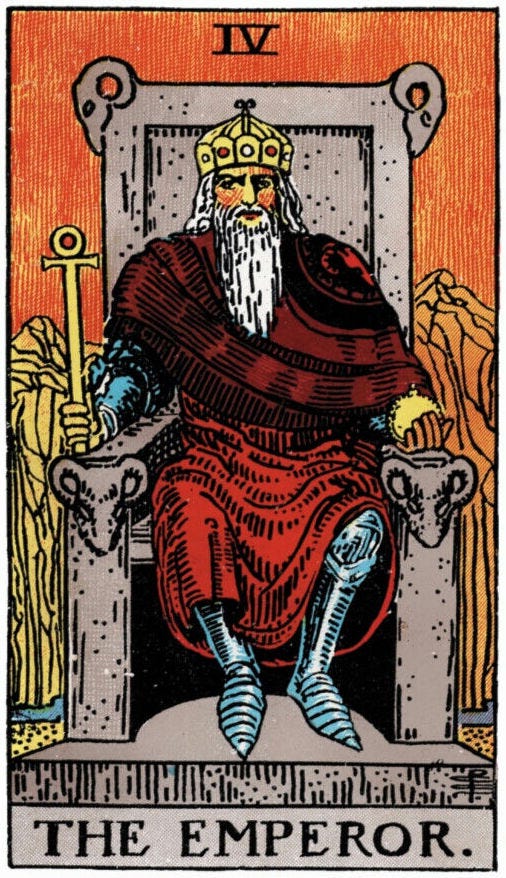I have long been drawn to the enigmatic and archetypal symbols of the Tarot. The cards always seemed to be telling an important story in a language just beyond our comprehension. In her book A Walk Through the Forest of Souls, Tarot practitioner and scholar Rachel Pollack writes:
“Tarot lies behind all other knowledge systems. The Tarot summarizes all the mysteries and discoveries of ancient masters. Know the Tarot, understand it correctly, and you will know everything.”
In a dream I had some time ago, I met a spiritual teacher who proclaimed, “There is no way we can know the infinite in its entirety.” Without hesitation, I replied, “Except for the Tarot.” When I woke up, I found this exchange had the sharp ring of truth. And so, as we travel around the wheel of the year together I will draw upon relevant cards from the Tarot, weaving their wisdom into this reflective practice.
The Tarot card most frequently associated with Aries is The Emperor, and some correspondences leap out immediately. The widely used Rider-Waite tarot deck shows a man seated on a throne adorned with ram’s heads, the symbol for Aries. The Emperor is dressed in red and flanked by mountain peaks. In his right hand he holds an ankh, the symbol of life. In his left, a golden orb symbolizing his dominion. He looks to his right, a bit suspiciously, as if checking for challengers. He has much to defend, and wears the armor of battle beneath his robes.
In the Gill Tarot, the deck I work most closely with, there are still more signs of The Emperor’s Aries-nature. The mountains in the background are now erupting volcanoes and the Emperor himself has risen to a more active, forward thrusting posture. The ram is still present, though now carried as a shield. The armor is gone from the Emperor’s legs which are bare and wrapped with sandal straps. Less defensive, this Emperor is surveying his domain and ascending to greater levels of authority.
Traditionally, the Emperor card represents leadership, power, control, and authority. You may think about leadership roles you have taken on in your family, amongst your community, or at work, and how you wish to direct the power of your authority. However, it is also worth considering self-leadership and the responsibility we have for governing our own lives. Do you identify more with the seated, defensive Emperor or the climbing, seeking one? Perhaps you see elements of both of them in your approach to inner authority. Or maybe you don’t have much of a relationship with your inner Emperor and would benefit from taking some time to get to know them better.
In another dream, I found myself climbing a series of neglected stairs to a threadbare “presidential suite”. I saw once fine furniture upholstered in yellow silk now left to deteriorate and gather dust. Clearly the “president” hadn’t graced these quarters in years. The upper floors of a building often signify the conscious mind, logic, and reason (while the basement represents the underworld of emotions and the subconscious). Yellow is the color of the solar plexus chakra, which is considered the seat of personal power and the sense of self (and is also traditionally associated with Aries). I understood this dream as a call to reclaim my own inner seat of power; to bring the Emperor back from his wanderings to the waiting throne of my conscious mind. You may wish to consider the state of your own Emperor’s quarters or presidential suite. Is it well maintained and fully staffed, or are there some changes you can make to renew and reappoint your own place of inner power?
Finally, I will share one more rendition of The Emperor that I created as I reflected on the Aries-nature of Nettle and its unique intermingling of the masculine (its violent sting) and the feminine (its offering of nourishment). The object on the top right of the composition is a prehistoric hand-axe, a tool of action and perhaps aggression, which I placed pointing downward to create a more yonic shape.
This piece is a companion to the first entry in this series: The Spring Equinox and Aries Season.






